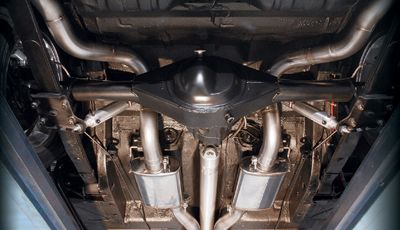
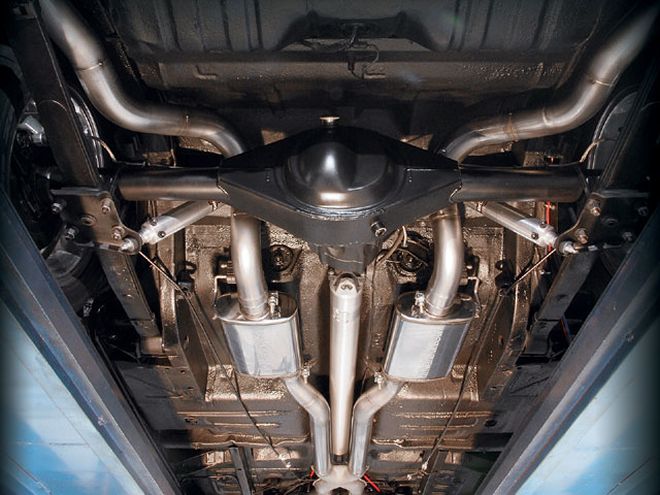
Nothing on Earth sounds better to a gearhead than an uncorked open-header engine. It's the sound of power, the thumping racket that makes you tingle all over. Unfortunately, if you want to drive on the street, that octane-fueled mechanical music needs to be knocked down a few decibels to satisfy the local constabulary. But silencing the beast under your hood doesn't have to put serious hurt on the power getting to the wheels. By selecting the right exhaust system, you can have the best of both worlds.
Our '70 Fairlane is offbeat-cool, but thinking outside of the box has a price. That price is that it's hard, or impossible, to find vehicle-specific performance parts. Everybody makes stuff for 69 Camaros, but when we looked foran off-the-shelf exhaust system for our Fairlane, we were greeted by the sound of crickets. This meant going custom. The folks at MagnaFlow had just the right parts in stock to build a system that would sound great without robbing power from the 552hp small-block residing under the hood.
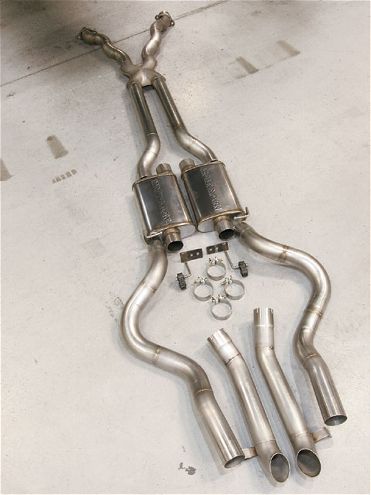 MagnaFlow doesn't make a kit for a '70 Fairlane, so we had to go custom. MagnaFlow measured, marked, cut, test-fit, trimmed, and tack welded the pieces together. Once everything was mocked, all the parts were TIG welded.
MagnaFlow doesn't make a kit for a '70 Fairlane, so we had to go custom. MagnaFlow measured, marked, cut, test-fit, trimmed, and tack welded the pieces together. Once everything was mocked, all the parts were TIG welded.
The decision was what size and type of system to install. Should it be 2.5- or 3-inch? Should it run all the way back or end after the mufflers? Is an X-pipe worth the extra coin? MagnaFlow does this for a living, and we decided to pick their brains to see where we would get the most performance benefit.
Regarding pipe diameter, Richard Waitas, engineering director for MagnaFlow, told us: "In choosing between a 3- and 2.5-inch exhaust for a dual-role street/strip car, considerations in sizing are not purely based on peak power. In a race application, it is easy to build an exhaust that will permit max cfm flow at peak horsepower rpm. In an all-out strip car with a high-stall converter and airflow ranged toward high rpm, the larger-diameter system will definitely shine, but this is only the case in an application where the powertrain is designed for peak performance. Determining where your application fits most should sway you from smaller to larger. In a more street or street/strip application, consideration for the rest of the curve should be made, as power delivery 'feel' will be substantially different. This feel is often the difference in torque or midrange horsepower. Some of this midrange power and low-rpm torque is more desirable in a daily driven car, and sacrificing five to six peak horsepower for the same amount in the midrange will make the power more useable. In looking at flow capacities of the two diameters in a dual-exhaust configuration, the transition point where the benefit of a 3-inch versus 2.5- inch exhaust start to drift apart is near the 400-450hp mark. At this point, the horsepower and torque variations become more substantial, and the loss and gain needs to be more carefully analyzed."
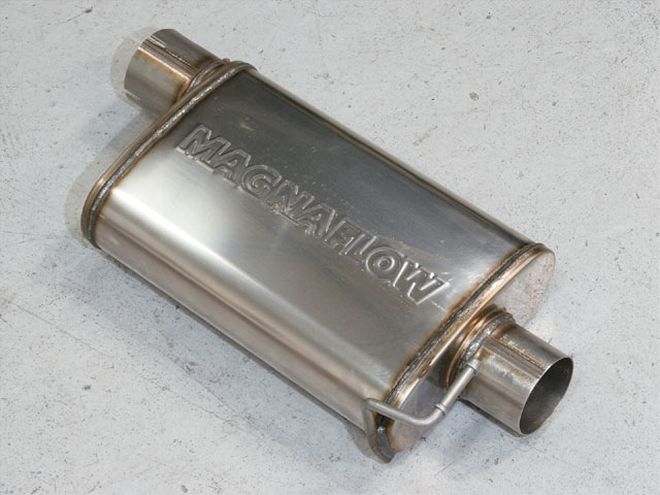 MagnaFlow's straight-through design silences without causing a bottleneck. "Our mufflers consist of a perforated core pattern wrapped in stainless steel wool for maximum longevity," says Richard.
MagnaFlow's straight-through design silences without causing a bottleneck. "Our mufflers consist of a perforated core pattern wrapped in stainless steel wool for maximum longevity," says Richard.
Since our initial goal is to get the Fairlane into the 11s, we decided a three-inch system would work better with our single-plane Victor Jr. intake. We also asked Richard about the need to run an X-pipe. "The X-pipe is an integral part of our design. The X-pipe has been around for a long time; however, many people only know it as something NASCAR uses or as a 'crossover' pipe. The X-pipe, or as we call it, the TRU-X, increases the efficiency of the exhaust system using scavenging. Scavenging is a means of using existing exhaust pulse energy to enhance total flow. To maximize the output of our TRU-X, it should be placed where it can utilize the high-speed gasses expelled from the engine at a point where the vacuum charge created as the exhaust pulse crosses the X can create a pressure drop to a bank of cylinders or individual cylinder in its exhaust stroke. The engine can more efficiently expel spent exhaust gasses, making for greater cylinder filling, which equates to more power."
With a plan in place, we trailered the Fairlane over to MagnaFlow's R&D center so they could tame the raucous sound from our 408 and help us get another step closer to hitting the track.
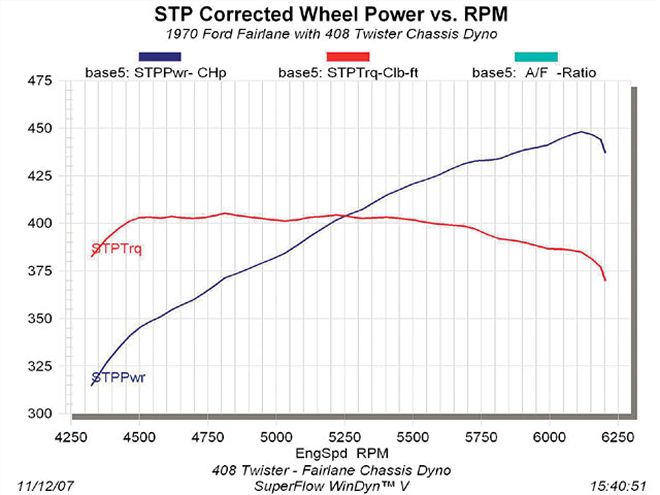
Chassis-Dyno ThrowdownWe started out with a 408 stroker that put out 552 hp and 530 lb-ft of torque on the Superflow engine dyno at Westech. Then we got curious how much of that the exhaust and drivetrain ate up, so we took it back to Westech for a run on the Superflow chassis dyno. Even though the 408 was perfectly tuned on the engine dyno, it needed a bit of tweaking in the car since it was running a bit fat at cruise. We swapped out the 73/73 jets in our Holley 950HP carb for a 76/70 combo, and we were rewarded with a best pull of 448 rear-wheel hp and 404 lb-ft of torque. It's reassuring to have the engine dyno numbers backed up on the chassis dyno. We attribute the loss of only 104 horsepower to the free-flowing FPA headers and three-inch MagnaFlow exhaust. Will e get into the 11s? According to our math, we ave a shot atit. Now where's that Chevelle?
WHERE THE MONEY WENT '70 {{{Ford}}} Fairlane 500: $8,{{{100}}}.00 408 stroker engine: $8,757.79 Hughes Performance C4 trans/converter/flywheel: $2,050.{{{90}}} Installation of 408 and C4 trans: $2,776.99 Vintage Wheel Works V60 wheels: $1,179.00 Nitto 555 tires: $594.00 Mount and Balance: $100.00 Used '70 Torino {{{GT}}} hood: $250.00 Paint and body: $250.00 Materials to paint rear valance: $15.00 New vinyl top: $119.95 Labor for top installation: $250.00 Front spoiler: $67.96 Line lock with lines: $96.90 SSBC front disc brakes: $999.95 Rotor upgrade: $150.00 Just Suspension "the works" kit: $1,{{{850}}}.00 Credit for unused KYB shocks: -$152.00 Alston double-adjustable Varishocks: $956.00 Alignment: $69.95 Strange 9-inch rearend with disc brakes: $2,423.72 Lokar e-brake cable kit: $144.95 Misc. hardware for rearend install: $86.44 Aluminum 3.5-inch driveshaft and parts: $470.00 {{{Odyssey}}}, Moroso, and other parts for battery relocation: $448.35 Stainless MagnaFlow three-inch exhaust system: $1,142.{{{80}}} Sold parts from Fairlane (tires, wheels, hood): $425.00 Total: $32,773.65